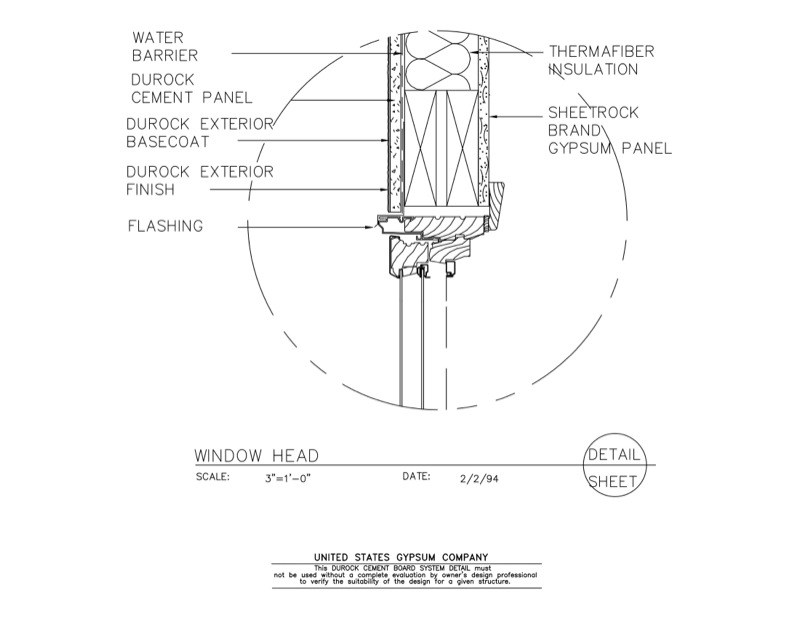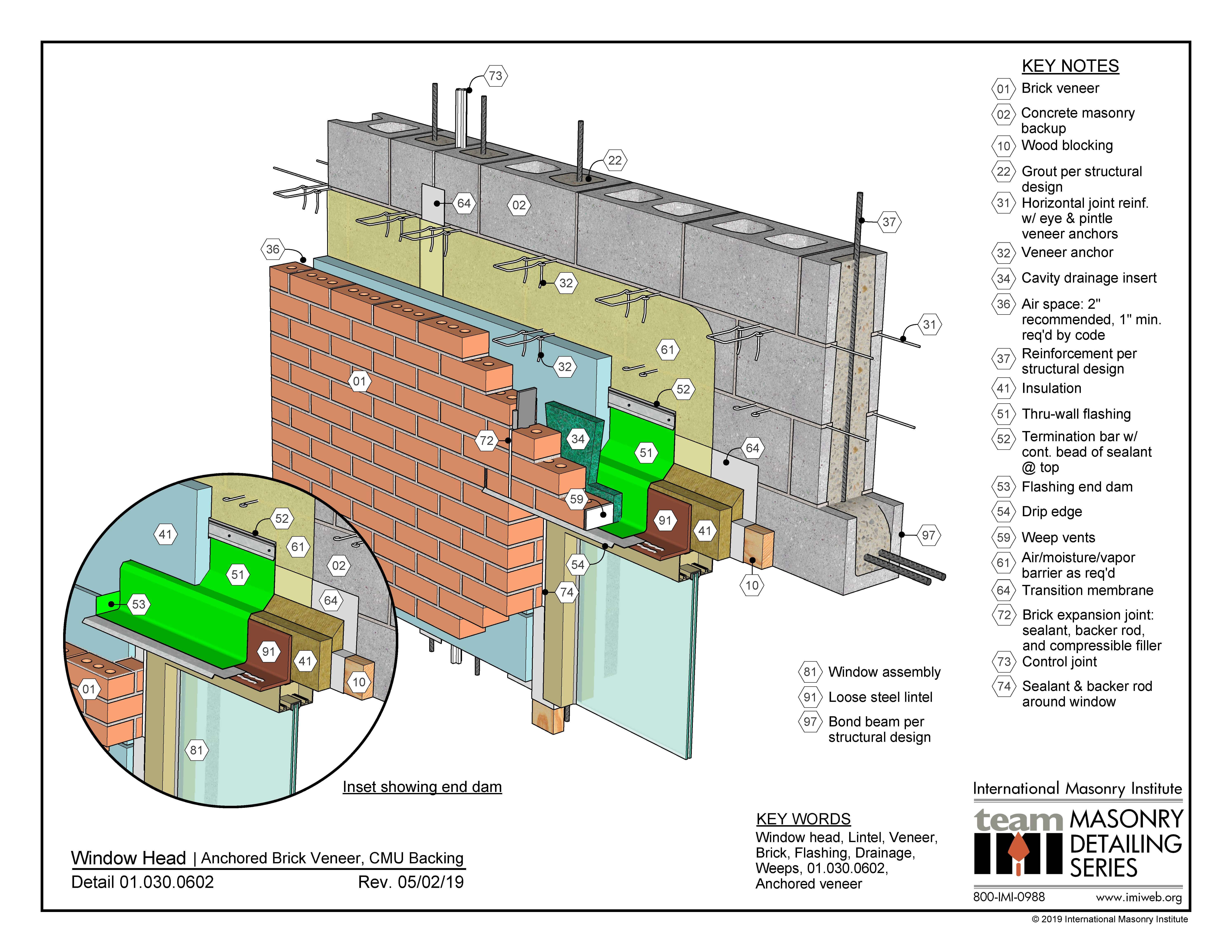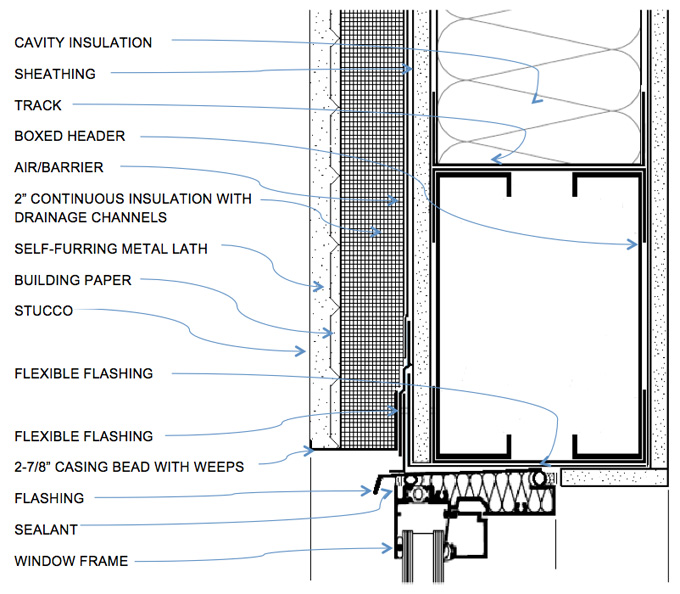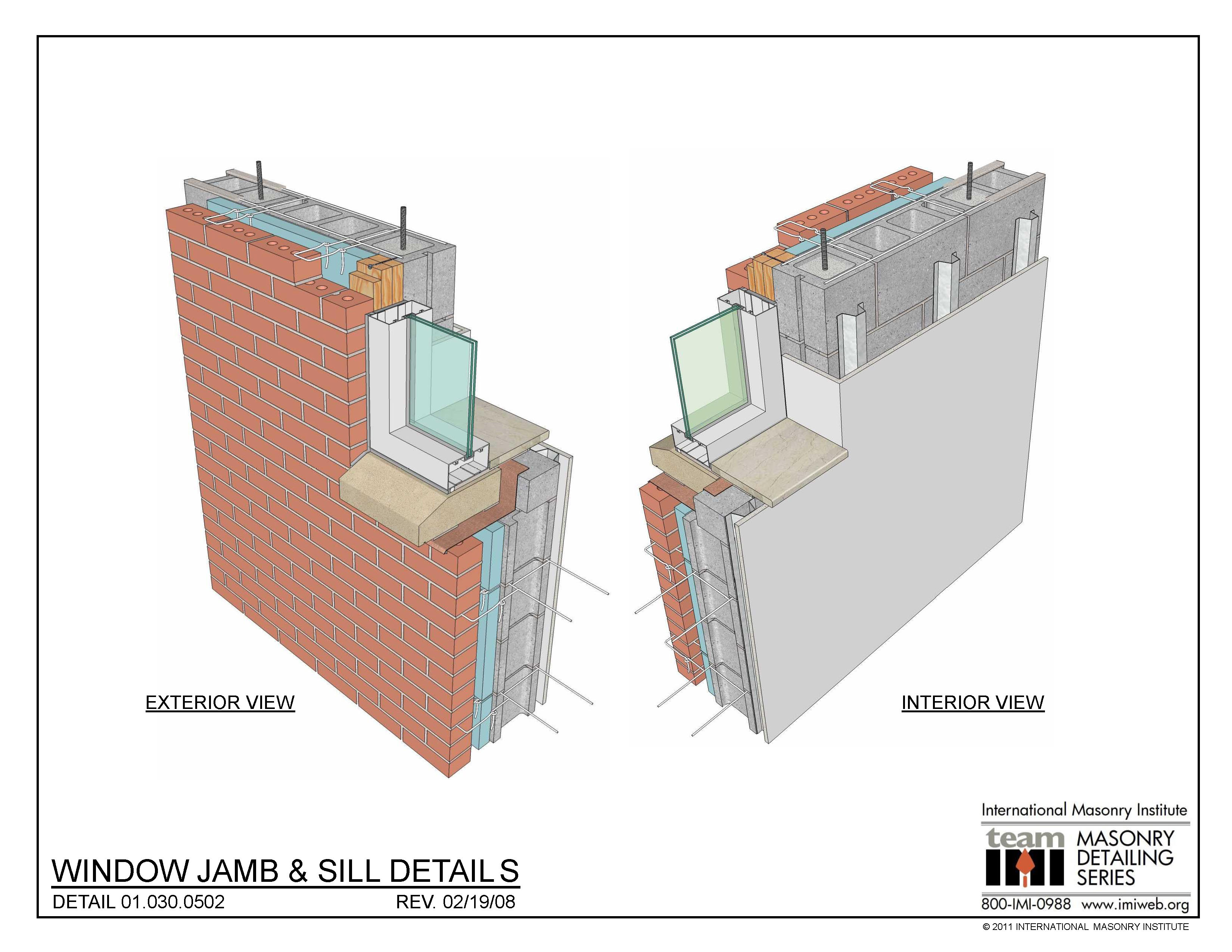
Head flashing for window with bevelback and cavity BRANZ Build
OVERVIEW: Windows are used in all claddings, how to detail the window sill, jamb and head for stucco will vary based on the following factors: • The type or style of window. There are basically flanged and non-flanged style windows. • Consider structure and its location. For example, a concrete high-rise in Miami will

Design Details Details Page Durock Window Head Detail
Part II. The sketch indicated above/below is a continuation of my previous post. The sketch shows how to detail the window head and sill in a masonry veneer, steel stud back up exterior wall. It is important to maintain water tight exterior skin and continue the weather barrier into the opening. One way to accomplish this is to use butyl tape.

01.030.0602 Window Head Detail Anchored Brick Veneer, CMU Backing
Retrofit Window Flashing. My house was built in 2001. The living room has a 2×8 wall. As a result, the aluminum windows are recessed. The sill angles down from left to right, a design detail, which has caused leakage. I've now exposed the Protecto Wrap flashing underneath and plan on re-flashing a sill pan.

Typical Window Detail BecoWallform Insulated Concrete Formwork
WINDOW HEAD DETAIL. GENERAL NOTES. Provide insulation and finish systems to meet EIMA Specifications. Installation of insulation and finish system shall be in accordance to EIMA's Guide to Exterior Insulation & Finish System Construction. Cavity Insulation omitted from box header for clarity. Provide air/water barrier compatible to EIFS.

Passivhaus window head and sill Architectural Plans/Models
Figure 1 Raked window head directly under soffit. Design solution. As there is no room to incorporate a window head flashing, use a 40 + × 18 mm timber trim fitted and sealed against the junction between the soffit and window frame head. This is based on detail 8A(f) in Acceptable Solution E2/AS1 to New Zealand Building Code clause E2 External moisture.

Detail Post Window Details First In Architecture
Detail Post - Window Details. This timber cladding details post includes excerpts and details from our book Understanding Architectural Details - Residential. The book is now in its fourth edition, and was updated to reflect the changes to the Building Regulations in June 2022. All of the construction details in the book comply with the.

Gallery of A Guide to Window Detailing and Installation 5
Window head detail - wood frame structure with wood siding (PDF | DWG) Wall penetration detail - wood frame structure with wood siding (PDF | DWG) Back to top . Commercial. Wall systems . Thermax™ Wall System . Thermax™ Wall System CAD Detail Set (PDF | DWG)

window head detail brick Google Search Brick veneer, Exterior brick
This detail illustrates a masonry window head condition. The concrete masonry backing is treated with blocking at the perimeter of the opening, which is wrapped with transition material that engages with the air/moisture/vapor barrier in the field of the wall. This provides continuous resistance to air and moisture.

01.030.0604 Window Head Detail Brick veneer, CMU backup, structural
Title: Building Envelope Design Guide: Window Head at Brick Veneer Detail Author: jmounts Created Date: 5/21/2009 11:14:55 PM

Head flashing for window with bevelback and cavity BRANZ Build
Window Head Detail in Cavity Wall (with Nailing Flange) (Detail 1/E) | PDF. This detail shows head construction at an aluminum window set in a masonry cavity wall under a steel lintel. This detail will not accommodate differential movement between the window frame and the back-up wall.

Exterior System Details Stucco AWCI Technology Center
On a building with 12-inch thick well-insulated walls, we'll slide the windows back 3 1/2 inches so that every window has an individual built-in overhang right above the window head. That means we install most windows as "in-betweenies" instead of "innies" or "outies.". Treat the window flange as an installation aid only, not as a.

Pin on arch_det_ENVELOPE
Typical Assembly: Interior gypsum board. Steel stud-framed wall. Closed-cell spray foam (CCSPF) insulation between studs (optional) and min. 2 inches continuous CCSPF. Single-wythe CMU wall with water-repellent admixture at block and mortar. Clear water-repellent. Sealant over backer rod. Fluid-applied air barrier and WRB flashing membrane.

Nichiha CAD and Architectural Details Nichiha USA
Legend. Typical Assembly: Interior gypsum board. Steel stud-framed wall. Closed-cell spray foam (CCSPF) insulation between studs (optional) and min. 2 inches continuous CCSPF. Single-wythe CMU wall with water-repellent admixture at block and mortar. Clear water-repellent. Storefront window on minimum 1⁄4-inch thick intermittent shims.

Building Envelope Blog Window Head, Jamb and Sill Details at metal siding
This is a detail of an exterior wall finished with stucco with a parapet to roof interface. DOWNLOAD: DWG / PDF (Right click to save these files) WINDOW HEAD DETAIL WITH STUCCO FINISH. This is a detail of an exterior wall with stucco finish at the window head. DOWNLOAD: DWG / PDF (Right click to save these files) WINDOW JAMB DETAIL WITH STUCCO.

Raking window head detail BRANZ Build
External Sill: At the base of a window, a sill is required to help evacuate water hitting the window. It is good practice for the sill to project at least 45mm beyond the face of the wall below.

01.030.0502 Window Jamb & Sill Details International Masonry Institute
01.030.0602: Window Head Detail - Anchored Brick Veneer, CMU Backing October 20, 2022 01.030.0705: Shelf Angle Detail - Anchored Brick Veneer, CMU Backing, Shelf Angle with Bracket-Type Standoffs